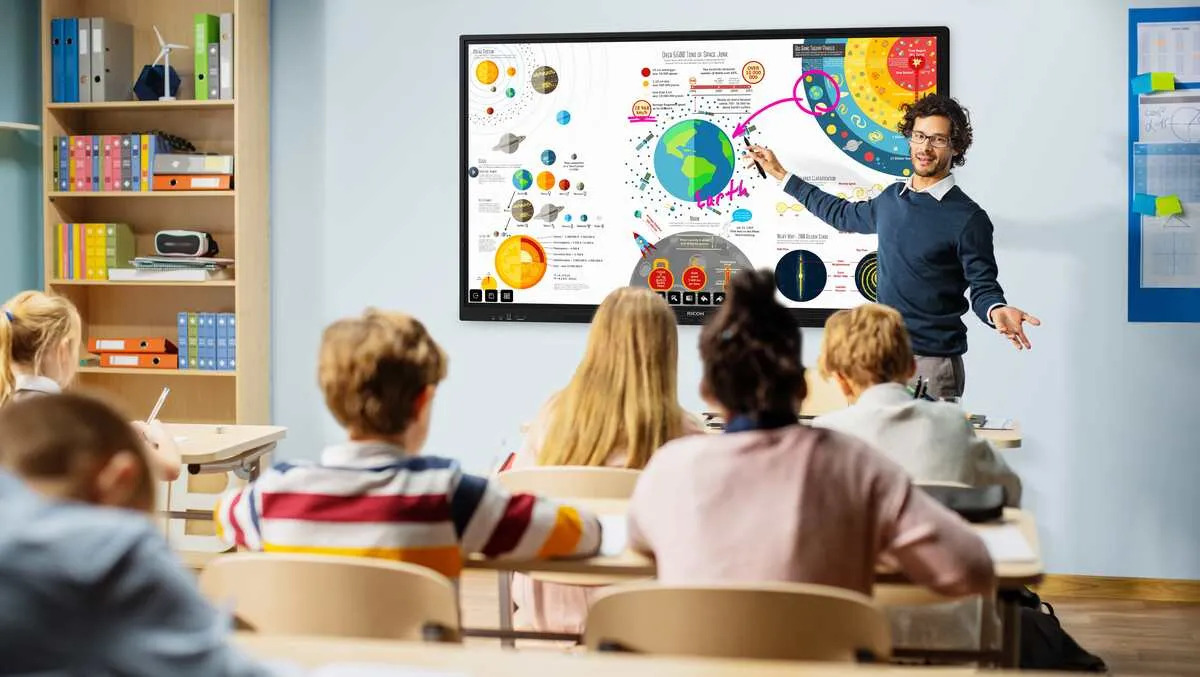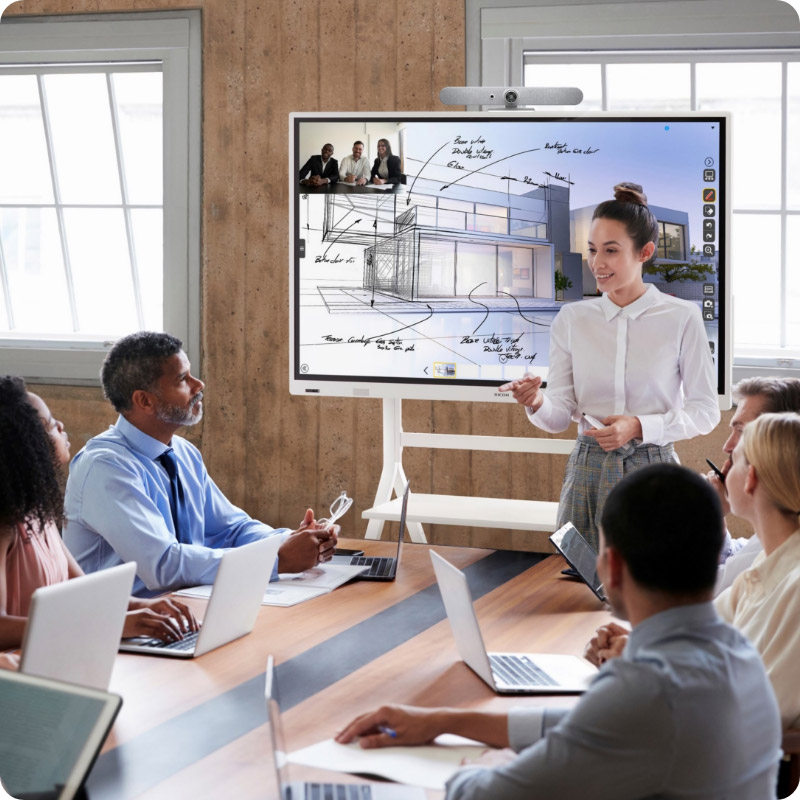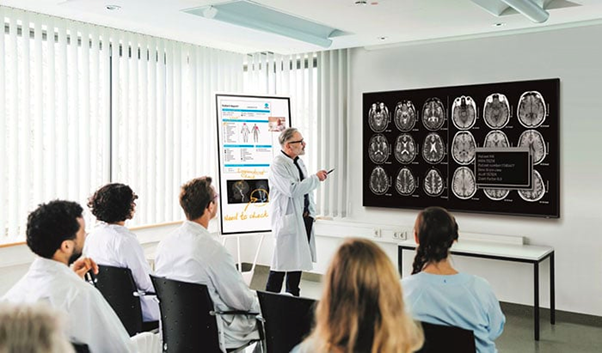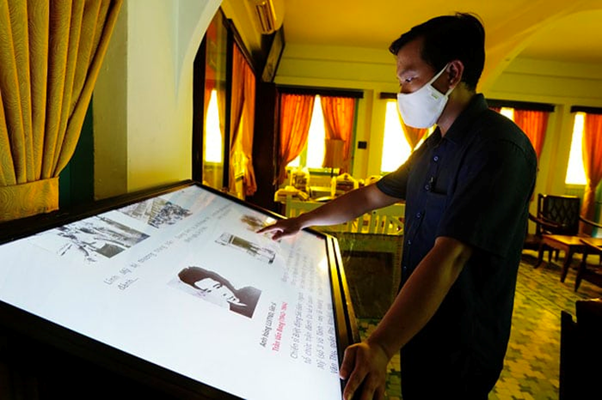What is an Interactive Screen? The User Guide and Benefits of Interactive Screen for Different Industries
1. What is an interactive whiteboard?
Interactive screens, also known as smart interactive screens, are a type of touch screen that allows users to interact directly using their fingers or a pen, similar to using a large tablet. It combines the functionality of an LCD screen, projector, and computer, providing optimal support for teaching and presentations.
Some notable features of smart interactive screens include the ability to connect to the internet, display multimedia content with high clarity, and easily connect to mobile devices through software.
Smart interactive screens come in various sizes, ranging from 55" to 86", and utilize popular screen types such as OLED, LCD, LED, with HD, Ultra Full HD, or 4K resolution to deliver clear and vibrant image quality.
The touch surface of the screen is equipped with a tempered glass layer, which protects the screen from impacts and dust. On top of that, there is a highly responsive touch layer that allows users to interact directly with images and videos.
2. The structure of an interactive screen.
The structure of an interactive screen is composed of 5 main components, each with its own characteristics and features as follows:
- Touchscreen: This component allows users to experience the most distinctive features of the interactive screen. It consists of 5 functional layers covering the outer surface: Multi-touch layer, Pen touch layer, Edge touch layer, Super touch layer, and Ultra-thin structure layers to enhance image quality.
- Tempered Glass: The glass part that wraps around the outside helps protect the main devices inside from the impact of strong interactions or collisions.
- Display screen: The integration and combination of screen technologies such as LED, LCD, OLED, etc., increase resolution and enhance image display.
- Integrated Mini PC and Android: This component holds the function that enables the screen to connect to the internet and store data. Depending on the user's needs, they can choose whether to integrate the Mini PC and Android or not, and use their personal laptop instead.
- Included software: These additional software components play an important role in supporting various purposes, such as text input, presentations, and classroom teaching activities.
3. Applications of smart interactive screens span various aspects of life:
a. In Smart Classrooms:
 Figure 1. Interactive screen in the classroom
Figure 1. Interactive screen in the classroomInteractive screens nowadays can completely replace traditional blackboards. Moreover, they allow for file storage and sharing, making teaching more convenient than ever. The strengths of interactive screens lie in their convenience and intuitiveness. Touching the screen enables natural and intuitive interaction, making it easy for users to quickly and effectively access information. Additionally, the compact installation of interactive screens helps save space and creates a modern and engaging interface.
b. In the Workplace:
 Figure 2. Interactive screen in the workplace
Figure 2. Interactive screen in the workplaceUsers can easily prepare in advance by using available software and then connecting to the interactive smart screen to present reports or ideas in their work. The direct touch feature allows presenters to interact naturally and flexibly with the content on the screen. They can move, zoom in, zoom out, and select elements on the screen conveniently. This enables them to focus on important details and explain clearly and vividly to the participants in the meeting or presentation.
c. In Healthcare:
 Figure 3. Interactive screen in healthcare
Figure 3. Interactive screen in healthcareThe use of specialized medical imaging such as CT scans, X-rays, etc., for diagnosis and medical consultations is essential. Therefore, the application of interactive screens in this field is indispensable. Interactive screens provide significant support for this purpose. Additionally, remote information exchange has become much more convenient.
d. In daily life:
 Figure 4. Interactive screen in daily life
Figure 4. Interactive screen in daily lifeCompact interactive screens are increasingly being widely used as a useful tool for providing guidance and gathering information at various locations such as hospitals, restaurants, hotels, and even ATMs. The integration of interactive screens makes the process of registration and interaction much easier and more convenient, optimizing the user experience.
Especially in museums and historical sites, interactive screens play a crucial role in presenting films and historical information. With this technology, guides can easily present and illustrate valuable heritage, attracting greater attention and understanding from visitors.
As interactive screens continue to be integrated into various fields and locations, they significantly contribute to enhancing user experiences and efficiently providing interactive and informative content.
4. Differentiating Interactive Screens from Smart Whiteboards
Comparison between interactive screens and smart whiteboards:
- Lifespan: Interactive screens typically have a longer lifespan than smart whiteboards. This means users can use the device for a longer period without the need for frequent replacements or maintenance.
- Accessories: Both interactive screens and smart whiteboards come with accessories such as touch pens or finger touch. However, interactive screens usually come with more features, including remote controllers and accompanying interactive software.
- Maximum touch points: Interactive screens and smart whiteboards have different maximum touch point capacities. Interactive screens usually have a higher multi-touch capability, allowing multiple users to interact with the screen simultaneously.
- Image/Video quality: Interactive screens generally provide higher image/video quality compared to smart whiteboards. This ensures that interactive content is displayed clearly and vividly.
- Audio: Interactive screens often have integrated speaker systems for audio output. On the other hand, smart whiteboards usually require separate speaker systems for audio output.
- Eye protection: Interactive screens are often equipped with eye protection features such as anti-glare and blue light reduction. This helps reduce eye strain during use. Smart whiteboards typically do not have these eye protection features.
5. Proper Use of Interactive Screens
- Using touch feature: Users can directly interact with the screen using their fingers or special touch pens.
- Inserting multimedia files: Files such as PowerPoint, Word, Excel and PDF can be directly opened for viewing, annotating and editing on IWB. Annotations on documents enhance participant understanding even in remote meetings. Annotations can be saved for later viewing on your PC.
- Using basic features like a whiteboard: Typically, interactive screens provide a toolbar for writing, drawing, erasing, inserting multimedia files, and linking with storage software.
- Seamless wireless presentation and collaboration: You can do wireless screen recording from any OS, such as Windows, iOS, Mac, Android, Chrome and Ubuntu. Make your meetings and classes more productive with the ability to display up to four screens at once. PC operation is also available from the wireless IWB.
- Intuitive operation with pen and palm: Different functions can be assigned to both ends of a pen, allowing multiple people to write in different colors. It is also possible to use your palm to intuitively erase objects
6. Advanced Features of Interactive Displays
Interactive displays have evolved significantly, offering features that enhance both teaching and collaboration:
- Multi-Touch Support: Allowing multiple users to interact simultaneously, fostering group activities and collaborative learning.
- Integration with Educational Software: Seamless compatibility with various educational platforms and tools, enabling dynamic lesson plans and interactive content.
- Cloud Connectivity: Facilitating access to documents and resources stored online, ensuring that materials are up-to-date and easily shareable.
- Annotation Tools: Providing teachers and presenters with the ability to highlight, draw, and write directly on the screen, enhancing engagement.
7. Practical Applications in Different Settings
Interactive displays are versatile tools applicable in various environments:
a. Education
- Interactive Lessons: Teachers can create engaging lessons with multimedia content, quizzes, and real-time feedback.
- Distance Learning: Supporting remote education by allowing teachers to conduct live sessions with interactive elements.
b. Corporate
- Presentations: Enhancing business presentations with dynamic visuals and interactive charts.
- Collaborative Meetings: Facilitating brainstorming sessions and strategy planning with real-time editing and note-taking.
c. Healthcare
- Training: Providing medical staff with interactive training modules and simulations.
- Patient Education: Helping patients understand procedures and treatments through visual aids.
8. Tips for Effective Implementation
To maximize the benefits of interactive displays:
- Training: Ensure that users receive adequate training to utilize all features effectively.
- Maintenance: Regularly update software and perform maintenance checks to keep the system running smoothly.
- Feedback: Gather user feedback to identify areas for improvement and tailor the use of the display to specific needs.
Updated benefits of interactive whiteboards in modern work & education
1. Boost Focus and Real-Time Engagement
Unlike traditional passive presentations, Ricoh interactive whiteboards allow users to write, draw, and edit directly on the screen, helping to:
- Increase active participation during meetings or lessons.
- Spark creativity and encourage immediate feedback.
- Deliver a more hands-on, immersive experience.
2. Optimized for Remote and Hybrid Collaboration
With native compatibility with Microsoft Teams, Zoom, and Google Meet, Ricoh IWB supports:
- Real-time content sharing with remote participants.
- Live annotation and collaboration from multiple users.
- Multi-device connectivity for seamless hybrid meetings.
3. Enhance Memory and Visual Thinking
Studies show that handwriting and drawing help improve memory retention. Ricoh IWBs support:
- Visual mapping (e.g. brainstorming, mind mapping).
- Color-coded notes to aid categorization and recall.
- Visual learning for better communication and comprehension.
4. Create Engaging, Dynamic Experiences
For product demos, client presentations, or internal training:
- No need to over-prepare slides — content can be built live.
- Customers can interact directly — tap to explore, drag-and-drop visuals.
- Leaves a stronger impression thanks to touch-based interaction.
5. Flexible Content Management and Security
- Save sessions as images, PDFs, or videos.
- Share easily via email or cloud platforms.
- Set passwords or user permissions to ensure data security.
6. Personalized Workspaces
Ricoh IWBs allow customizable layouts and tools, including:
- Integrated clocks, calendars, or team notifications.
- Access to learning apps or business platforms like LMS or ERP.
Ricoh Interactive Whiteboards – Connect Through Touch
Designed for business. With its easy-to-use interface and built-in Apps, the new whiteboards offer seamless communication and collaboration. Ideal for hybrid working, allowing multiple people to write on the same screen.
NEW SERIES: RICOH A6510 – A7510 – A8610
Ricoh has launched its next-generation interactive whiteboard series, including the A6510 (65″), A7510 (75″), and A8610 (86″), with notable upgrades:
- Integrated Google EDLA, optimized for both educational and office environments.
- Brightness ≥ 400 cd/m², supports 40 touch points with multi-user input.
Highlight: Smooth and highly responsive touch experience — ideal for presentations, team collaboration, and virtual conferencing applications.
Related articles
News & Events
Keep up to date
- 18Dec
Ricoh recognised as a Top 5 global AV Integrator in SCN Top 50 Systems Integrators 2025
- 11Dec
Ricoh Recognised as a Sustainability Leader in Quocirca's 2025 Report
- 07Nov
Ricoh Pro C7500 Gold Toner Brings Sustainable Luxury to Sun PhuQuoc Airways’ Travel Guide
- 31Oct
Ricoh perovskite solar cells installed on Japan Aerospace Exploration Agency cargo transfer spacecraft1 HTV-X1
